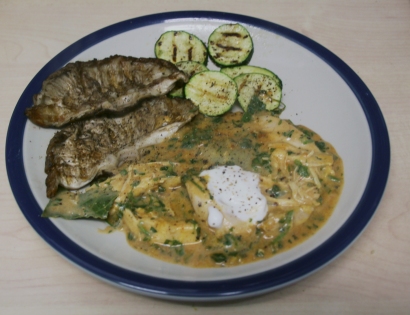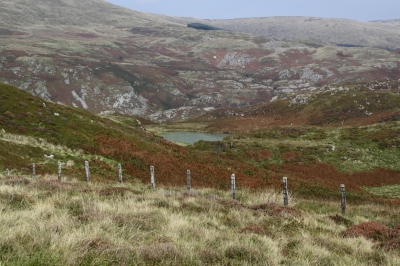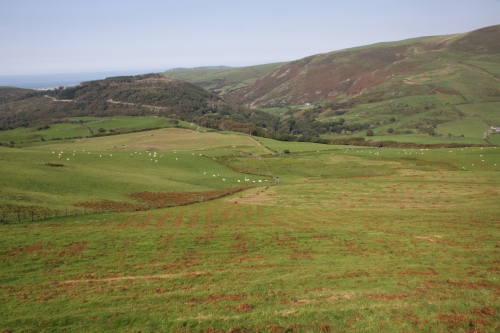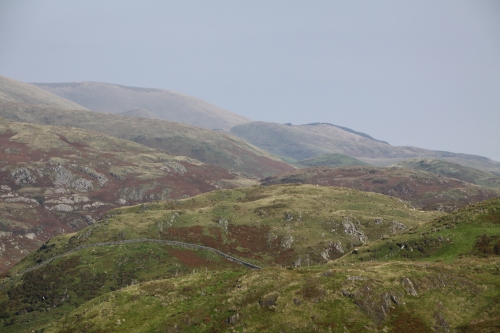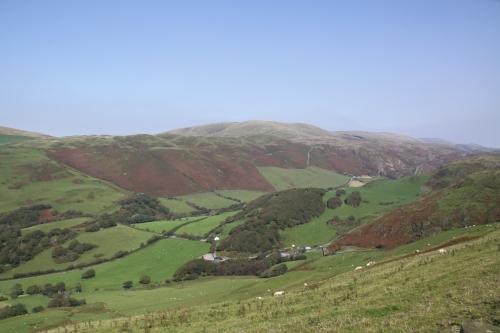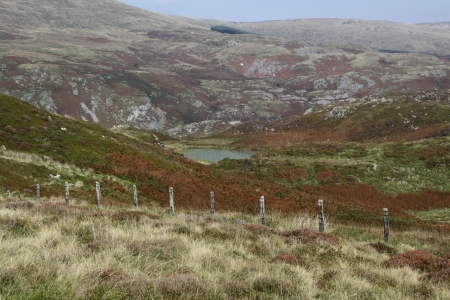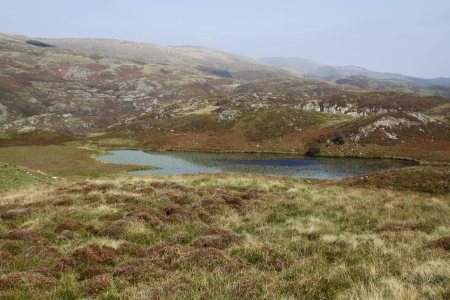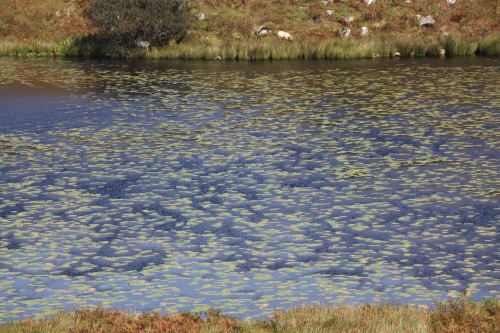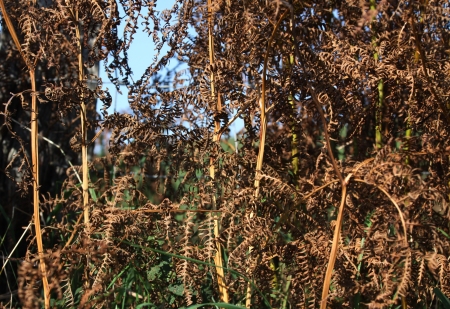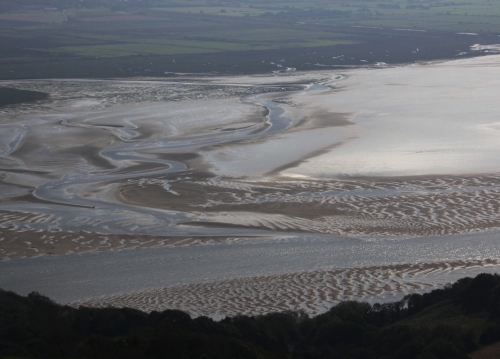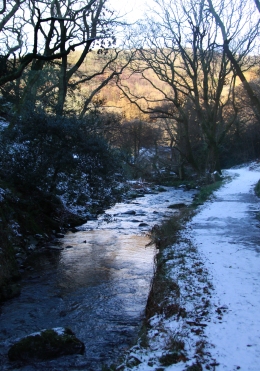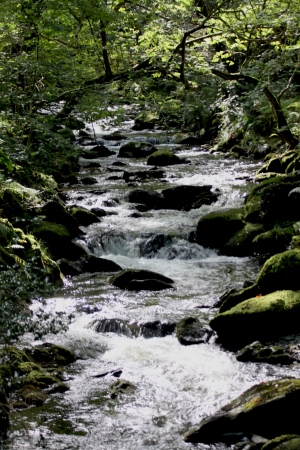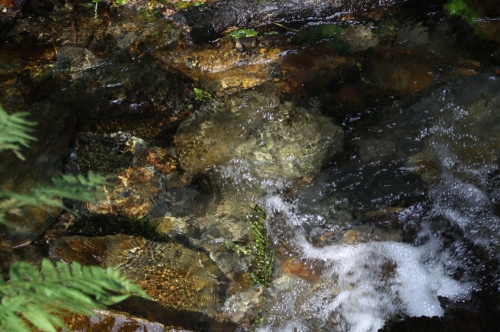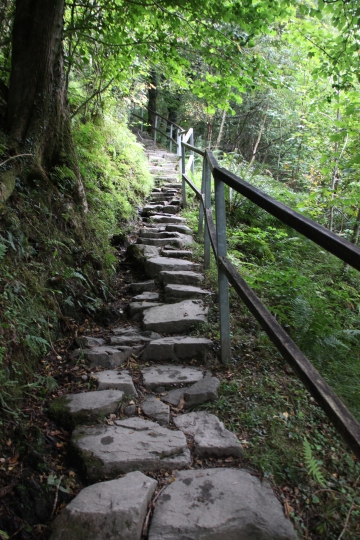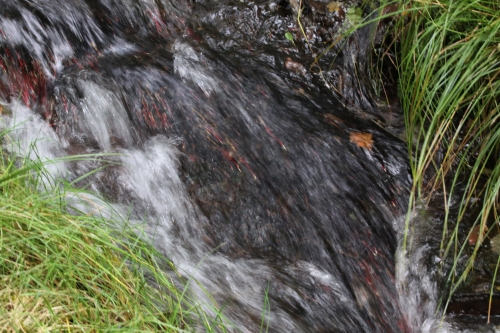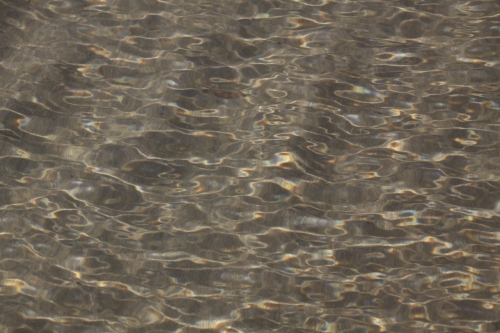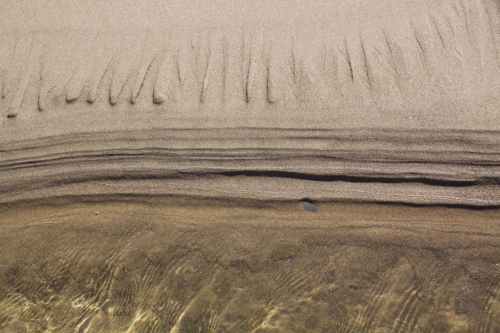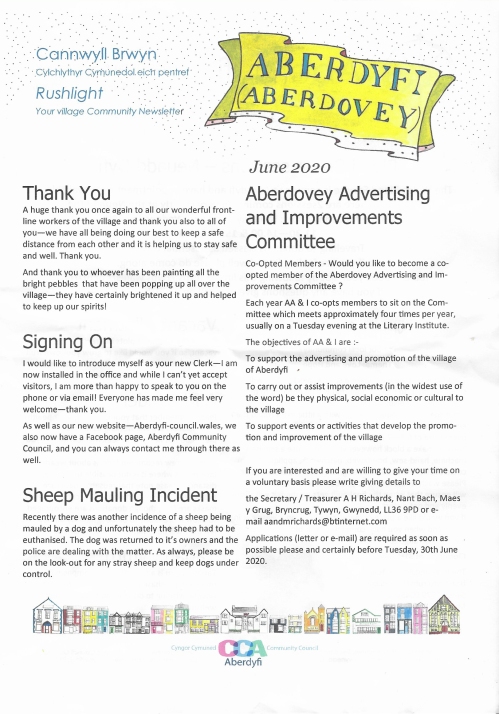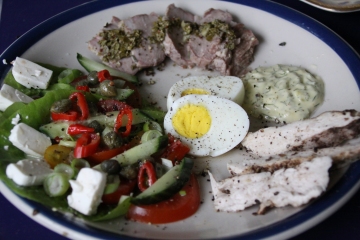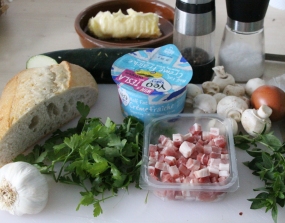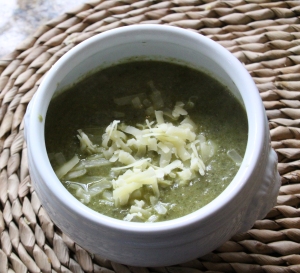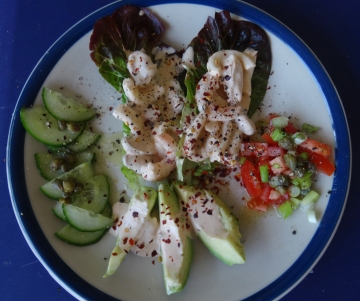 This is my final post about eating during lockdown. I feel that 12 weeks worth of me bunnying on about cooking is probably about as much as anyone truly needs 🙂 Additionally, I defrosted the freezer mid-week and found that most of the contents consists of meals that I had batch-cooked to divide equally between the plate and the freezer. By which I mean that I ate half and froze the other half. It’s about time I started eating those other halves rather than creating more, or there will be no freezer space left! There will be another post in a couple of weeks about my encounters with a locally sourced cuttlefish, but unless I can source some unusual local ingredients to talk about, I think that my culinary lockdown sharing has come to a natural end, an end to absolute lockdown, and a trailing off of my learning curve.
This is my final post about eating during lockdown. I feel that 12 weeks worth of me bunnying on about cooking is probably about as much as anyone truly needs 🙂 Additionally, I defrosted the freezer mid-week and found that most of the contents consists of meals that I had batch-cooked to divide equally between the plate and the freezer. By which I mean that I ate half and froze the other half. It’s about time I started eating those other halves rather than creating more, or there will be no freezer space left! There will be another post in a couple of weeks about my encounters with a locally sourced cuttlefish, but unless I can source some unusual local ingredients to talk about, I think that my culinary lockdown sharing has come to a natural end, an end to absolute lockdown, and a trailing off of my learning curve.
Lockdown kicked in on 23rd March. I was originally supposed to be celebrating my birthday a few days after that date with a small lunch party, but a couple of weeks before lockdown was announced we decided to cancel it, because it was quite clear that the tide of the Covid-19 was rolling in very fast. One of thousands of cancelled celebrations and gatherings, minor and major. So I cooked for myself on my birthday, and seriously enjoyed a roasted rack of lamb from the freezer, only the second meal on my Week 1 post about eating well from what was to hand. I had realized by then that I would have to change my ad hoc shopping and cooking regime, and organize myself so that I would only have to do one relatively large shop once a fortnight. It had the charm of novelty at first, but a few weeks in and I was longing to go back to a less regimented way of buying and eating. 12 weeks in, and I am now accustomed to it, if not overjoyed by it.

Oregano growing in a pot in my garden
Fortunately, it has not all been about local supermarkets and the freezer. Dropping off bags of groceries to my self-isolating father has had its own reward, mainly for the pleasure of having a long-distance chat sitting well apart in comfy chairs in the garden for a couple of hours, with ample use of hand disinfectant, but also, with an eye to my pots and pans, in the form of delicious home-grown vegetables, lettuces and herbs. Following the small relaxation of the lockdown rules I have taken advantage of the occasional foray into both the Aberdovey and Tywyn butchers, and have loved being able to buy fish from Dai’s Shed, when the weather has allowed Dai to take the boat out.
I have no intention of visiting a big supermarket for many weeks yet. The government may have faith in people behaving responsibly, but after one recklessly optimistic foray into a medium-sized supermarket a couple of weeks ago I walked out in serious dismay at the risks being taken. I cannot imagine that matters will be improving as the relaxation of rules continues.
Saturday
 Prawns, avocado, mushrooms and baby spinach with parmesan, cream and a Panko topping. In Week 7, I made my first attempt to reproduce a recipe using avocados that was served as a starter in a favourite London restaurant, which closed when the owners returned to Italy. This is a modified version.
Prawns, avocado, mushrooms and baby spinach with parmesan, cream and a Panko topping. In Week 7, I made my first attempt to reproduce a recipe using avocados that was served as a starter in a favourite London restaurant, which closed when the owners returned to Italy. This is a modified version.
Sometimes the Coey sells single avocados, large ones, but when I was last there there were only small avocados in a packet of two, so I used one at the end of last week and had one left to use. I also had some button mushrooms and pancetta left over from last week’s egg-topped mushrooms and pancetta on toast. It was clearly an opportunity to repeat, with revisions, my reverse engineering of the Venezia dish using fridge orphans. I am unable to buy raw prawns locally, even frozen, but the Coey had cooked frozen ones in a seafood mix, and I had some raw ones left in the freezer. There weren’t enough prawns, so I threw in some squid rings as well, and that worked well.
 I fried some button mushrooms, and added a fine-chopped clove of garlic and some pancetta cubes until well cooked. I sprinkled over some flour, just enough to help it thicken. As before, I added a glug of white wine and some water to form a base for the sauce, but to make it a bit healthier, instead of a lot of cream, I added chicken stock and only a small dollop of low fat crème fraîche, with some grated Paremsan cheese. I then added the cooked prawns and squid, plus two handfuls of spinach to heat through. I left this to reduce for a couple of minutes, gave it a good stir, seasoned it with some salt and black pepper, and then, just as the sauce was reducing to the right amount, put in the sliced half avocado to allow that to heat through. If the avocado is very ripe, be careful not to move it around too much when you put it in, or it will break up. The avocado needs to be no more than warmed through, so must remain on the heat for only a couple of minutes on a low heat before serving or, again, it will break up.
I fried some button mushrooms, and added a fine-chopped clove of garlic and some pancetta cubes until well cooked. I sprinkled over some flour, just enough to help it thicken. As before, I added a glug of white wine and some water to form a base for the sauce, but to make it a bit healthier, instead of a lot of cream, I added chicken stock and only a small dollop of low fat crème fraîche, with some grated Paremsan cheese. I then added the cooked prawns and squid, plus two handfuls of spinach to heat through. I left this to reduce for a couple of minutes, gave it a good stir, seasoned it with some salt and black pepper, and then, just as the sauce was reducing to the right amount, put in the sliced half avocado to allow that to heat through. If the avocado is very ripe, be careful not to move it around too much when you put it in, or it will break up. The avocado needs to be no more than warmed through, so must remain on the heat for only a couple of minutes on a low heat before serving or, again, it will break up.
 To serve, I turned it into a terracotta tapas dish, provided it with a good sprinkling of chilli flakes, sprinkled some Panko (Japanese) bread crumbs to give it crunchy gratin topping, shaved some fresh Gran Pardano cheese over the top and put it under the grill until it began to bubble and brown. To serve, I added some more black pepper and scattered fresh oregano over the top. Without all the cream, it was less unctuous but a bit healthier, and with the Panko topping it had a lot more texture to balance the avocado. The chili and oregano were good additions, balancing the relative mildness of the sauce. It would go well with a side salad, but I didn’t need one.
To serve, I turned it into a terracotta tapas dish, provided it with a good sprinkling of chilli flakes, sprinkled some Panko (Japanese) bread crumbs to give it crunchy gratin topping, shaved some fresh Gran Pardano cheese over the top and put it under the grill until it began to bubble and brown. To serve, I added some more black pepper and scattered fresh oregano over the top. Without all the cream, it was less unctuous but a bit healthier, and with the Panko topping it had a lot more texture to balance the avocado. The chili and oregano were good additions, balancing the relative mildness of the sauce. It would go well with a side salad, but I didn’t need one.
Sunday
 Leftovers frittata. This is basically a quiche without the pastry, or a Spanish omelette without the potatoes. I had some bits and pieces of courgette, cheese, onion, spinach, bacon and parsley left over, and some eggs that were hurtling towards their eat-by-date with indecent haste.
Leftovers frittata. This is basically a quiche without the pastry, or a Spanish omelette without the potatoes. I had some bits and pieces of courgette, cheese, onion, spinach, bacon and parsley left over, and some eggs that were hurtling towards their eat-by-date with indecent haste.
This is such an easy dish that there’s almost nothing to say about it. I wilted the spinach, fried the courgette and bacon and put everything else into four whisked eggs. I heated it through on the hob and then put it under the grill to finish it off. A quick and simple meal, but full of flavour.
Monday
 Smoked sausage and sauerkraut in mustard sauce. This is a made-up meal, one I invented a long time ago. I only discovered sauerkraut a few years ago, in a super and very unusual restaurant in London called Zedel, when my father ordered some, having been a fan for life, and I tried his. I had tried it when younger and disliked it, but as I have aged by tastes have changed and I loved it.
Smoked sausage and sauerkraut in mustard sauce. This is a made-up meal, one I invented a long time ago. I only discovered sauerkraut a few years ago, in a super and very unusual restaurant in London called Zedel, when my father ordered some, having been a fan for life, and I tried his. I had tried it when younger and disliked it, but as I have aged by tastes have changed and I loved it.
I used to be able to buy Polish kielbasa smoked sausage in my local Tesco in London, which had a Polish aisle. It’s one of the many things that have been more difficult to acquire since leaving London. However, at long last my father has been able to place an Ocado order, and very kindly ordered me some French smoked sausage. As I had a jar of sauerkraut in the cupboard, some German mustard, an enormous box of caraway seeds, some baby new potatoes (any spuds would do), a bit of sour cream, some fridge-orphan pancetta (bacon lardons would be more authentic), and plenty of onion, it was a no-brainer to go for a Polish-style one-pot. Slices of apple go well too, but I didn’t have any. A high-sided frying pan or skillet is best for this, as it can be a bit messy when you are stirring everything together.
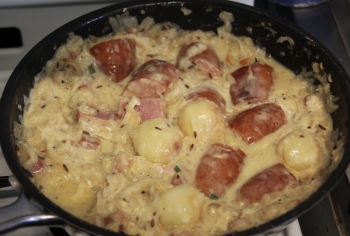 First, the baby new potatoes are boiled until just cooked. I peeled them, but it’s not actually necessary, just really very nice for a change as they absorb flavours much more efficiently than if you leave the skins on. Then I spooned sauerkraut into a bowl of water and left it to allow the preserving liquid to disseminate into the water for at least 10 minutes before draining it through a sieve and squashing out the water with the back of a wooden spoon.
First, the baby new potatoes are boiled until just cooked. I peeled them, but it’s not actually necessary, just really very nice for a change as they absorb flavours much more efficiently than if you leave the skins on. Then I spooned sauerkraut into a bowl of water and left it to allow the preserving liquid to disseminate into the water for at least 10 minutes before draining it through a sieve and squashing out the water with the back of a wooden spoon.
 The smoked sausage is cut into chunks, heated through, set aside and kept warm. In the same pan, to take advantage of the sausage flavours, a teaspoon of caraway seeds and several good turns of a pepper mill are added. The onion and pancetta are heated until the pancetta is crispy and the onion golden, and are removed from pan. The new potatoes are drained and added to the pan to brown. Then it all goes back in to the pan, with the sauerkraut and mustard, and a dessert spoon of flour stirred in to thicken the sauce. Some white wine, stock or water are then added. It is heated gently with a lid on for 10 minutes, with wine/stock, and mustard added by the spoonful until the preferred balance of flavours and the right amount of liquid is achieved. Then a dollop of cream is added (whatever you have to hand) and stirred in. I like it with smoked paprika stirred in at the last moment, chopped spring onions added over the top (partly for the flavour, partly to diminish the somewhat off-puttingly anaemic appearance) and a big dollop of sour cream on the side. It all looks chaotic on the plate, but it is delicious. Mine had some additional heat, because I had added a fresh chilli to the onion and pancetta, which isn’t traditional but suited me perfectly.
The smoked sausage is cut into chunks, heated through, set aside and kept warm. In the same pan, to take advantage of the sausage flavours, a teaspoon of caraway seeds and several good turns of a pepper mill are added. The onion and pancetta are heated until the pancetta is crispy and the onion golden, and are removed from pan. The new potatoes are drained and added to the pan to brown. Then it all goes back in to the pan, with the sauerkraut and mustard, and a dessert spoon of flour stirred in to thicken the sauce. Some white wine, stock or water are then added. It is heated gently with a lid on for 10 minutes, with wine/stock, and mustard added by the spoonful until the preferred balance of flavours and the right amount of liquid is achieved. Then a dollop of cream is added (whatever you have to hand) and stirred in. I like it with smoked paprika stirred in at the last moment, chopped spring onions added over the top (partly for the flavour, partly to diminish the somewhat off-puttingly anaemic appearance) and a big dollop of sour cream on the side. It all looks chaotic on the plate, but it is delicious. Mine had some additional heat, because I had added a fresh chilli to the onion and pancetta, which isn’t traditional but suited me perfectly.
If you prefer a tidier and more presentable meal, you can cook the sausage whole, and in a separate pan cook the sauerkraut, onion and pancetta to accompany it, and in another pan make the mustard sauce separately. If you do it this way, you will probably need to make a velouté (my preference) or béchamel to ensure that your mustard sauce has some body to it. I would finely chop some chives into it too.
Tuesday
 Adapted Nalli Gosht lamb shank and okra curry with basmati rice and minted labneh. I used a recipe I found on the Internet (see Maunika Gowardhan) for this, as I don’t have any Indian cookbooks, and I am useless at inventing Indian dishes. The lamb shank came from the freezer, via the Aberdovey butcher, who kindly picked out a small one for me that was perfect for this dish. I decided to do it in the slow cooker, which departs from the recipe on the above link, but I made very few other changes: I used skinned and chopped fresh tomatoes and a bit of tomato paste rather than all tomato paste, I had red rather than green chillis, used cassia bark instead of cinnamon, and I changed some of the proportions of the spices to suit my own tastes, adding a lot more ginger, but otherwise followed the recipe closely. I accidentally used smoked paprika rather than mild paprika for the marinade, but fortunately I realized the moment it hit the bowl and used the mild paprika for the sauce itself, and the smoked paprika didn’t spoil it. I added the last of the frozen okra, and made a minted labneh to go with it.
Adapted Nalli Gosht lamb shank and okra curry with basmati rice and minted labneh. I used a recipe I found on the Internet (see Maunika Gowardhan) for this, as I don’t have any Indian cookbooks, and I am useless at inventing Indian dishes. The lamb shank came from the freezer, via the Aberdovey butcher, who kindly picked out a small one for me that was perfect for this dish. I decided to do it in the slow cooker, which departs from the recipe on the above link, but I made very few other changes: I used skinned and chopped fresh tomatoes and a bit of tomato paste rather than all tomato paste, I had red rather than green chillis, used cassia bark instead of cinnamon, and I changed some of the proportions of the spices to suit my own tastes, adding a lot more ginger, but otherwise followed the recipe closely. I accidentally used smoked paprika rather than mild paprika for the marinade, but fortunately I realized the moment it hit the bowl and used the mild paprika for the sauce itself, and the smoked paprika didn’t spoil it. I added the last of the frozen okra, and made a minted labneh to go with it.
The process is simple, but see the above link for the unadulterated step-by-step version. The lamb shank is marinated overnight in a blended mixture of garlic, ginger, mild paprika, and coriander powder (I had coriander seeds in a grinder).
 When ready to cook, fry cinnamon stick (or in my case cassia bark), green cardamoms, cloves and peppercorns in butter and oil, allow to sizzle for a few seconds and then add the onions and chilli slices. Cook til golden and then add the turmeric and coriander powder. The recipe calls for the addition of the tomato paste followed by the lamb shank. I was using peeled tomatoes, so I put the shank in first to brown, added the blended tomatoes next with a single spoon of tomato paste, and the yoghurt afterwards. I then tipped the whole lot into the slow cooker, but the original recipe calls for it to be simmered for 20-25 minutes on the hob, with a lid slightly open. I carved the lamb shank to save faffing around with it on the plate, spooned the sauce over the top, and although it tasted great its appearance was less than beautiful. I suggest you look at the source web page for presentation tips.
When ready to cook, fry cinnamon stick (or in my case cassia bark), green cardamoms, cloves and peppercorns in butter and oil, allow to sizzle for a few seconds and then add the onions and chilli slices. Cook til golden and then add the turmeric and coriander powder. The recipe calls for the addition of the tomato paste followed by the lamb shank. I was using peeled tomatoes, so I put the shank in first to brown, added the blended tomatoes next with a single spoon of tomato paste, and the yoghurt afterwards. I then tipped the whole lot into the slow cooker, but the original recipe calls for it to be simmered for 20-25 minutes on the hob, with a lid slightly open. I carved the lamb shank to save faffing around with it on the plate, spooned the sauce over the top, and although it tasted great its appearance was less than beautiful. I suggest you look at the source web page for presentation tips.
The recipe suggests serving with naan bread, but I had some plain basmati rice boiled in stock with fennel seeds, and some minted labneh on the side to balance the heat.
 Labneh is simply drained yoghurt. In a bid to eat a rather healthier diet I bought some low fat Greek yoghurt, and it was incredibly liquid so I decided to turn it into labneh. The only equipment required is either muslin or kitchen roll, a sieve and a bowl or equivalent. A couple of pinches of salt are mixed into the yoghurt, and it is poured into the lined sieve to drain, preferably overnight. Once the liquid is removed, the yoghurt is malleable enough to form into balls. I like to mix herbs or spices into the drained yoghurt before doing so, usually a Moroccan spice mix, but on this occasion I used mint. It can be preserved in oil in a re-used jar as I have done here, flavoured with herbs and spices, in this case lemon, mint leaves and sliced chilli. It is delicious served with curry, Middle Eastern stews, or simply on cheese crackers as a snack.
Labneh is simply drained yoghurt. In a bid to eat a rather healthier diet I bought some low fat Greek yoghurt, and it was incredibly liquid so I decided to turn it into labneh. The only equipment required is either muslin or kitchen roll, a sieve and a bowl or equivalent. A couple of pinches of salt are mixed into the yoghurt, and it is poured into the lined sieve to drain, preferably overnight. Once the liquid is removed, the yoghurt is malleable enough to form into balls. I like to mix herbs or spices into the drained yoghurt before doing so, usually a Moroccan spice mix, but on this occasion I used mint. It can be preserved in oil in a re-used jar as I have done here, flavoured with herbs and spices, in this case lemon, mint leaves and sliced chilli. It is delicious served with curry, Middle Eastern stews, or simply on cheese crackers as a snack.
 .
.
.
Wednesday
 Deep-fried whitebait with caper and gherkin mayonnaise and salad. I’ve had a single remaining starter-sized portion of whitebait in the freezer for a very long time now. I’ve been keeping them for when I really, really wanted them and absolutely nothing else would do, because I’m not going to be able to replace them until after the lockdown. Lovely, lovely little fish, simply rolled in flour whilst still frozen, deep-fried on a high heat for a couple of moments and served with Tabasco, and a gherkin and caper mayonnaise. I don’t actually have a deep fat fryer, so I poured Crisp and Dry into a baby wok, and heated it until one little fishy started to fizz in the oil. Tipping the rest of them in lowers the temperature significantly, so I turned up the heat until the oil started to bubble again. It’s a dicey business if you are heating oil in a pan rather than in a thermostat-controlled fryer, so make sure you have a couple of damp tea towels to hand in case it sets fire to itself. It has never happened to me, but it did to a friend of mine.
Deep-fried whitebait with caper and gherkin mayonnaise and salad. I’ve had a single remaining starter-sized portion of whitebait in the freezer for a very long time now. I’ve been keeping them for when I really, really wanted them and absolutely nothing else would do, because I’m not going to be able to replace them until after the lockdown. Lovely, lovely little fish, simply rolled in flour whilst still frozen, deep-fried on a high heat for a couple of moments and served with Tabasco, and a gherkin and caper mayonnaise. I don’t actually have a deep fat fryer, so I poured Crisp and Dry into a baby wok, and heated it until one little fishy started to fizz in the oil. Tipping the rest of them in lowers the temperature significantly, so I turned up the heat until the oil started to bubble again. It’s a dicey business if you are heating oil in a pan rather than in a thermostat-controlled fryer, so make sure you have a couple of damp tea towels to hand in case it sets fire to itself. It has never happened to me, but it did to a friend of mine.
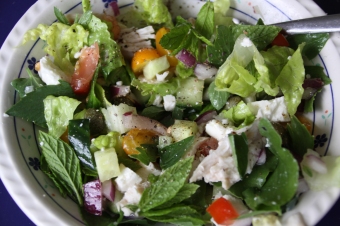 I served my whitebait with a salad to make it into a main course. I’ve never managed to make a tartar sauce that is both quick and delicious, but making a mayonnaise and then adding chopped gherkins and capers with a bit of parsley isn’t a bad substitute. I have lovage, so added a couple of leaves of that too (lovage can be overpowering so it pays to add it just a little at a time, tasting before adding any more).
I served my whitebait with a salad to make it into a main course. I’ve never managed to make a tartar sauce that is both quick and delicious, but making a mayonnaise and then adding chopped gherkins and capers with a bit of parsley isn’t a bad substitute. I have lovage, so added a couple of leaves of that too (lovage can be overpowering so it pays to add it just a little at a time, tasting before adding any more).
Thursday
 Griddled lamb chop, mashed carrot and swede, leek, cabbage and boiled and roast potatoes. In pouring rain, I was craving comfort food, and this was a good match for my mood. It was very much a case of using up leftovers (carrot and swede mash and lamb gravy from last week, taking up space in the freezer) and fridge orphans (a bit of cabbage and a piece of leek). Although I love roast potatoes I wouldn’t heat an entire oven for them, but I was also cooking something else at the same time. As I’ve done this a couple of times before, I won’t add more details, but I really enjoyed it.
Griddled lamb chop, mashed carrot and swede, leek, cabbage and boiled and roast potatoes. In pouring rain, I was craving comfort food, and this was a good match for my mood. It was very much a case of using up leftovers (carrot and swede mash and lamb gravy from last week, taking up space in the freezer) and fridge orphans (a bit of cabbage and a piece of leek). Although I love roast potatoes I wouldn’t heat an entire oven for them, but I was also cooking something else at the same time. As I’ve done this a couple of times before, I won’t add more details, but I really enjoyed it.
Friday
 Cold lamb chop, watermelon, feta, cucumber, red onion, mint, olives with a lemon, white wine vinegar and olive oil dressing, seasoned with sea salt and black pepper. When I cooked my lamb chop with traditional roast-related veg yesterday, I cooked two chops, so that I had one left over for this salad. The first time I had a lamb and watermelon salad was on Kefalonia, and the only barrier to repeating it has been the immense size of watermelons (called sandía where I grew up), which are so difficult to use up. It was therefore a fairly ecstatic moment when I walked into the Tywyn Co-Op and found that they were selling baby ones. So happy! Watermelon is a match made with heaven with feta, red onion, cucumber and black olives, which was very handy as I had all of these that needed using up. The oil and vinegar might sound a little odd with melon, but in fact both, together with the lemon juice, balance the flavours beautifully.
Cold lamb chop, watermelon, feta, cucumber, red onion, mint, olives with a lemon, white wine vinegar and olive oil dressing, seasoned with sea salt and black pepper. When I cooked my lamb chop with traditional roast-related veg yesterday, I cooked two chops, so that I had one left over for this salad. The first time I had a lamb and watermelon salad was on Kefalonia, and the only barrier to repeating it has been the immense size of watermelons (called sandía where I grew up), which are so difficult to use up. It was therefore a fairly ecstatic moment when I walked into the Tywyn Co-Op and found that they were selling baby ones. So happy! Watermelon is a match made with heaven with feta, red onion, cucumber and black olives, which was very handy as I had all of these that needed using up. The oil and vinegar might sound a little odd with melon, but in fact both, together with the lemon juice, balance the flavours beautifully.
Conclusions
 Since the lockdown began and I started shopping once a fortnight, I have learned a lot not merely about planning ahead, but also planning around the leftovers and fridge orphans that I knew I would generate. Leftovers are the remains of cooked meals; fridge orphan is a term I’ve invented for the unused odds and ends left behind after the use of their companions in the meals for which they were planned. A few mushrooms, some potatoes, small chunks of cheese and bits of courgette are typical examples. It’s a big change from doing things the other way round, looking at what ingredients I had left in the fridge and buying things to go with them. They now have to be used up without shopping. With this in mind, I started to leave gaps in the meal-planner so that I could bring together leftovers and fridge orphans with items in the freezer, such as last week’s chicken pie. That is not to say that there is never any kitchen waste, but matters are considerably improved.
Since the lockdown began and I started shopping once a fortnight, I have learned a lot not merely about planning ahead, but also planning around the leftovers and fridge orphans that I knew I would generate. Leftovers are the remains of cooked meals; fridge orphan is a term I’ve invented for the unused odds and ends left behind after the use of their companions in the meals for which they were planned. A few mushrooms, some potatoes, small chunks of cheese and bits of courgette are typical examples. It’s a big change from doing things the other way round, looking at what ingredients I had left in the fridge and buying things to go with them. They now have to be used up without shopping. With this in mind, I started to leave gaps in the meal-planner so that I could bring together leftovers and fridge orphans with items in the freezer, such as last week’s chicken pie. That is not to say that there is never any kitchen waste, but matters are considerably improved.
 Over the last 12 weeks people have commented on how diverse my tastes are, but I am regarded by family and friends as a fussy eater, on good grounds. I am mildly but genuinely allergic to capiscum (green/red peppers), I cannot stand coconut, I abhor tinned tuna, find tinned tomatoes dreadfully sweet, and think that cornflakes are an abomination. I dislike pulses like beans and chickpeas, (although I love lentils and black beans), I’m really not keen on offal, I simply don’t understand adding raisins or bananas to savoury food, I eat nearly all green vegetables but find 80% of them exceedingly dull, and I have tried time and time again to learn to love blue cheeses, because I know I’m missing out, but I can’t. On the other hand, baby watermelons rock! The picture looks disconcertingly like Pac-Man 🙂
Over the last 12 weeks people have commented on how diverse my tastes are, but I am regarded by family and friends as a fussy eater, on good grounds. I am mildly but genuinely allergic to capiscum (green/red peppers), I cannot stand coconut, I abhor tinned tuna, find tinned tomatoes dreadfully sweet, and think that cornflakes are an abomination. I dislike pulses like beans and chickpeas, (although I love lentils and black beans), I’m really not keen on offal, I simply don’t understand adding raisins or bananas to savoury food, I eat nearly all green vegetables but find 80% of them exceedingly dull, and I have tried time and time again to learn to love blue cheeses, because I know I’m missing out, but I can’t. On the other hand, baby watermelons rock! The picture looks disconcertingly like Pac-Man 🙂
I think that the main thing I learned is that even with a relatively confined repertoire of ingredients, truly enjoyable things can be achieved, and by using herbs and spices the same ingredients can be given a completely different character.
Thanks to everyone who took the time to read my culinary experiments, and particularly to those who got in touch – email is a wonderful thing. Please continue to practice social distancing and please stay safe!

 Well the news today is first that in Wales we are going back into lockdown for a 17-day “firebreak” period from Friday 23rd October until Monday 9th November. Second, according to the NHS Covid app loaded on my phone, the LL35 postcode (Aberdovey) is now a High Risk area for Covid. Not terribly surprising, though, after the summer influx. Hey ho.
Well the news today is first that in Wales we are going back into lockdown for a 17-day “firebreak” period from Friday 23rd October until Monday 9th November. Second, according to the NHS Covid app loaded on my phone, the LL35 postcode (Aberdovey) is now a High Risk area for Covid. Not terribly surprising, though, after the summer influx. Hey ho.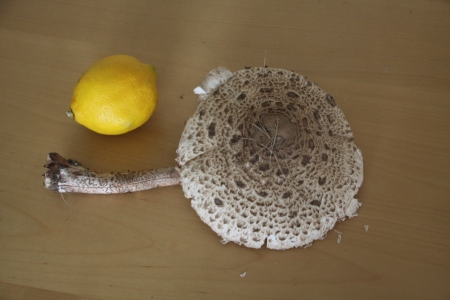 On the golf course I was hoping for some wild mushrooms, and just as I had given up, and was about to walk over the dunes to the beach, I spotted a single parasol (Macrolepiota procera) in the tall grass where the sand dunes meet the golf course. A beauty, and a real result. It was so perfect that it was almost a shame to eat it, but eat it I did.
On the golf course I was hoping for some wild mushrooms, and just as I had given up, and was about to walk over the dunes to the beach, I spotted a single parasol (Macrolepiota procera) in the tall grass where the sand dunes meet the golf course. A beauty, and a real result. It was so perfect that it was almost a shame to eat it, but eat it I did.